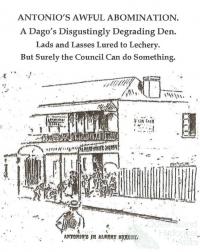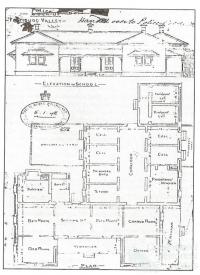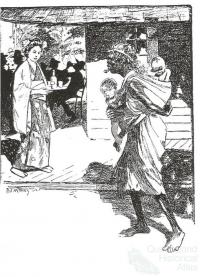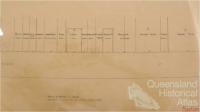- Home
- Quintessential Queensland
- Distinctiveness
- Perceptions
- Perceptions: how people understand the landscape
- From runs to closer settlement
- Geological survey of Queensland
- Mapping a new colony, 1860-80
- Mapping the Torres Strait: from TI to Magani Malu and Zenadh Kes
- Order in Paradise: a colonial gold field
- Queensland atlas, 1865
- Queensland mapping since 1900
- Queensland: the slogan state
- Rainforests of North Queensland
- Walkabout
- Queenslanders
- Queenslanders: people in the landscape
- Aboriginal heroes: episodes in the colonial landscape
- Australian South Sea Islanders
- Cane fields and solidarity in the multiethnic north
- Chinatowns
- Colonial immigration to Queensland
- Greek Cafés in the landscape of Queensland
- Hispanics and human rights in Queensland’s public spaces
- Italians in north Queensland
- Lebanese in rural Queensland
- Queensland clothing
- Queensland for ‘the best kind of population, primary producers’
- Too remote, too primitive and too expensive: Scandinavian settlers in colonial Queensland
- Distance
- Movement
- Movement: how people move through the landscape
- Air travel in Queensland
- Bicycling through Brisbane, 1896
- Cobb & Co
- Journey to Hayman Island, 1938
- Law and story-strings
- Mobile kids: children’s explorations of Cherbourg
- Movable heritage of North Queensland
- Passages to India: military linkages with Queensland
- The Queen in Queensland, 1954
- Transient Chinese in colonial Queensland
- Travelling times by rail
- Pathways
- Pathways: how things move through the landscape and where they are made
- Aboriginal dreaming paths and trading ways
- Chinese traders in the nineteenth century
- Introducing the cane toad
- Pituri bag
- Press and the media
- Radio in Queensland
- Red Cross Society and World War I in Queensland
- The telephone in Queensland
- Where did the trams go?
- ‘A little bit of love for me and a murder for my old man’: the Queensland Bush Book Club
- Movement
- Division
- Separation
- Separation: divisions in the landscape
- Asylums in the landscape
- Brisbane River
- Changing landscape of radicalism
- Civil government boundaries
- Convict Brisbane
- Dividing Queensland - Pauline Hanson’s One Nation Party
- High water mark: the shifting electoral landscape 2001-12
- Hospitals in the landscape
- Indigenous health
- Palm Island
- Secession movements
- Separate spheres: gender and dress codes
- Separating land, separating culture
- Stone walls do a prison make: law on the landscape
- The 1967 Referendum – the State comes together?
- Utopian communities
- Whiteness in the tropics
- Conflict
- Conflict: how people contest the landscape
- A tale of two elections – One Nation and political protest
- Battle of Brisbane – Australian masculinity under threat
- Dangerous spaces - youth politics in Brisbane, 1960s-70s
- Fortress Queensland 1942-45
- Grassy hills: colonial defence and coastal forts
- Great Shearers’ Strike of 1891
- Iwasaki project
- Johannes Bjelke-Petersen: straddling a barbed wire fence
- Mount Etna: Queensland's longest environmental conflict
- Native Police
- Skyrail Cairns (Research notes)
- Staunch but conservative – the trade union movement in Rockhampton
- The Chinese question
- Thomas Wentworth Wills and Cullin-la-ringo Station
- Separation
- Dreaming
- Imagination
- Imagination: how people have imagined Queensland
- Brisbane River and Moreton Bay: Thomas Welsby
- Changing views of the Glasshouse Mountains
- Imagining Queensland in film and television production
- Jacaranda
- Literary mapping of Brisbane in the 1990s
- Looking at Mount Coot-tha
- Mapping the Macqueen farm
- Mapping the mythic: Hugh Sawrey's ‘outback’
- People’s Republic of Woodford
- Poinsettia city: Brisbane’s flower
- The Pineapple Girl
- The writers of Tamborine Mountain
- Vance and Nettie Palmer
- Memory
- Memory: how people remember the landscape
- Anna Wickham: the memory of a moment
- Berajondo and Mill Point: remembering place and landscape
- Cemeteries in the landscape
- Landscapes of memory: Tjapukai Dance Theatre and Laura Festival
- Monuments and memory: T.J. Byrnes and T.J. Ryan
- Out where the dead towns lie
- Queensland in miniature: the Brisbane Exhibition
- Roadside ++++ memorials
- Shipwrecks as graves
- The Dame in the tropics: Nellie Melba
- Tinnenburra
- Vanished heritage
- War memorials
- Curiosity
- Curiosity: knowledge through the landscape
- A playground for science: Great Barrier Reef
- Duboisia hopwoodii: a colonial curiosity
- Great Artesian Basin: water from deeper down
- In search of Landsborough
- James Cook’s hundred days in Queensland
- Mutual curiosity – Aboriginal people and explorers
- Queensland Acclimatisation Society
- Queensland’s own sea monster: a curious tale of loss and regret
- St Lucia: degrees of landscape
- Townsville’s Mount St John Zoo
- Imagination
- Development
- Exploitation
- Transformation
- Transformation: how the landscape has changed and been modified
- Cultivation
- Empire and agribusiness: the Australian Mercantile Land and Finance Company
- Gold
- Kill, cure, or strangle: Atherton Tablelands
- National parks in Queensland
- Pastoralism 1860s–1915
- Prickly pear
- Repurchasing estates: the transformation of Durundur
- Soil
- Sugar
- Sunshine Coast
- The Brigalow
- Walter Reid Cultural Centre, Rockhampton: back again
- Survival
- Survival: how the landscape impacts on people
- Brisbane floods: 1893 to the summer of sorrow
- City of the Damned: how the media embraced the Brisbane floods
- Depression era
- Did Clem Jones save Brisbane from flood?
- Droughts and floods and rail
- Missions and reserves
- Queensland British Food Corporation
- Rockhampton’s great flood of 1918
- Station homesteads
- Tropical cyclones
- Wreck of the Quetta
- Pleasure
- Pleasure: how people enjoy the landscape
- Bushwalking in Queensland
- Cherbourg that’s my home: celebrating landscape through song
- Creating rural attractions
- Festivals
- Queer pleasure: masculinity, male homosexuality and public space
- Railway refreshment rooms
- Regional cinema
- Schoolies week: a festival of misrule
- The sporting landscape
- Visiting the Great Barrier Reef
By:
Yorick Smaal Prostitution is a difficult concept to define. Its most simple form involves direct payment for sex although historians acknowledge that the process and meaning of these transactions is messy; they are historically and culturally contingent, governed by a complex mix of power relations. In turn-of-the-century Queensland, prostitution was viewed predominantly through imported British lenses of gender, class, and race; often they were tinted with exaggeration and hyperbole. This was especially true when it came to street-walkers, working-class women, and Asian immigrants. Imperial models constructed a spatial order which identified immoral women and the spaces they inhabited. The authorities marked out certain locations for surveillance and created facilities to remove and segregate deviant individuals for punishment, treatment, and potential reform. Brothels themselves were simultaneously cast as illicit, morally corrupt and undesirable, but accepted as a necessary outlet that might contain and confine working-class and ethnic sexualities and prevent depravity from spilling onto the streets.
Gender and class
Queensland’s public space in this period was predominantly a male domain; the masculine legacy of a colonial frontier world continued to echo through the early decades of the twentieth century, resonating outside the metropolitan south-east corner and the major regional centres dotting the eastern seaboard. Arguably, this feature was so heavily embedded in the landscape that any public woman might have been cast as a prostitute or considered dangerously close to becoming one. In this environment, respectable women were always private; they displayed restraint and stifled any overt or explicit sexuality, ideas inherently associated with middle-class values. Working-class women, on the other hand, were assumed to possess less self-discipline and were considered more likely to succumb to corrupt influences and subsequently ‘fall’ into public habits.
Race
Asian immigrants also came in for special concern, allegedly importing immorality and vice as part of their cultural baggage. This nexus was not lost on the press who were quick to point out the lurking dangers posed by Asian establishments. Setting aside any misrepresentation by the newspapers, North Queensland, in particular, was a racially heterogeneous world and estimates suggest that non-Europeans here accounted for almost forty percent of the population in 1901. Thursday Island and coastal townships such as Innisfail and Cairns, and to the south, Mackay and Bundaberg, housed populations of Japanese prostitutes in the late 1890s. These women may have engaged in prostitution to help bankroll other business interests and finance capital accumulation. Northern settlements were also home to Chinatowns where brothels, opium dens, and sly grog shops sat alongside temples and trade stores. These activities were tolerated, in part, because of the significant presence of South Pacific Islanders in this reach of the colony; the ‘Birdcage’, a brothel operating in 1892 in Bundaberg, for example, was well known for its services to the male Kanaka population.
Urban vice
Numerous locations in the capital, Brisbane, were also reputed hubs of female deviance. The most notorious of these could be found in the East Ward, an area in the city proper which took in a series of rundown buildings in Albert Street known as the ‘nine holes’, and other venues in nearby Charlotte, Mary and Margaret streets. In the early 1890s, two adjacent houses of ill-fame in this precinct accommodated six girls and one madam. The police observed 23 men enter the house between 11 pm and 2 am and apparently, ‘there were nine other houses occupied by prostitutes within 100 yards of [this] residence’. The lessors of premises in this area recognised the profitability of the trade peddled here, charging women twice as much rent for a house as would be anticipated in ‘respectable neighbourhoods’. Other infamous zones included Fortitude Valley and South Brisbane (the latter became increasingly notorious in the first decade of the twentieth century), and elsewhere in Brisbane, a small number of brothels operated out of inner city suburbs such as Toowong, Red Hill and Ashgrove around the same time.
The more reputed houses of ill-fame were often characterised as rowdy and rambunctious. At one West End property, women apparently wandered about in the nude using foul and obscene language and cars and clients arrived at all hours of the night. Nearby residents claimed that these antics disturbed otherwise respectable citizens with those affected unable to sleep on verandahs for fear of offence. It was also alleged that such behaviour would also affect the value of property: residents in some areas threatened to sell their houses at a loss. Many public claims of this kind were found to be unsubstantiated by the police.
Regional and mining centres
In regional centres, operations were more circumspect with brothel owners in smaller towns often disguising the nature of their business. In 1896, one disorderly house in the main street of Longreach appeared to function as a legitimate refreshment store with any soliciting only taking place quietly indoors. Similar patterns are evident in Maryborough and Cairns in the early twentieth century. Prostitutes were also known to frequent parks and paddocks and operate from humpies and tents. This feature of prostitution appears especially marked in regional and rural areas notwithstanding urban patterns of Brisbane’s public space. Temporary arrangements were often the norm in mining centres. In 1911, for example, sexual services were provided from ‘a small humpy on Ruby Ridge near the Incinerator’ in Millchester, near Charters Towers, while three women solicited men by moonlight in the Mount Morgan Company paddocks near Rockhampton.
Controlling prostitution
Prostitution in fin de siècle Queensland was governed by a series of laws and regulations. The state deployed a range of mechanisms to control and contain female deviancy, segregating certain women in lock-ups, prisons and lock hospitals; and in the name of reform, industrial homes, where fallen girls and women might be saved and returned to their rightful place in the home. The most insidious and repressive provisions were contained in An Act for the Prevention of Contagious Diseases (31 Vict. No. 40). Modelled on British precedent, this legislation was introduced to the colony in 1868. This so-called public health measure was really designed to control the unrespectable poor, especially women, allowing the authorities to monitor, register and incarcerate infected women. After 1911, the Health Act Amendment Act (2 Geo. V. No. 26) cast venereal disease as a health disorder rather than a crime although the lock-hospital remained a salient feature of the legislation. Clause 132E of the Act made all forms of sexual solicitation punishable by fine, imprisonment or detention in a reformatory. As one newspaper report in 1911 noted, the provisions were considered to ‘affect chiefly women of ill-fame and the men who act as their paramours, both of whom are liable to spread infection, and both of whom at some time or another may find their way into gaol’.
Alongside these measures, criminal charges could be deployed under existing nineteenth century statute law although it was not until the Queensland Criminal Code was introduced in January 1901 that meaning of ‘bawdy house’ was explicitly defined. Arguably, the most readily deployed policing instrument used to control prostitution was the summary offences contained in the vagrants’ acts. They loosely-defined obscene, immoral and petty criminal behaviour and provided the authorities with a range of charges to detain wayward women. Alongside these measures, local councils relied on by-laws to control prostitutes and their establishments, although Brisbane inspectors noted the difficulties in controlling houses of ill-fame, acknowledging that when they closed down one residence, it simply moved to another district. According to evidence submitted to the Fitzgerald Inquiry in the late 1980s, a number of turn-of-the century brothels continued operate as late as the 1950s.
References and Further reading (Note):
Christopher Dawson, Intemperance and the train of evil: a life on the wrong side of the tracks in colonial Brisbane, Fairfield Gardens, Boggo Road Gaol Historical Society, 2008
References and Further reading (Note):
Raymond Evans, ‘“Soiled doves”: prostitution in colonial Queensland’, in Kay Daniels (ed), So much hard work: women and prostitution in Australian history, Sydney, Fontana Collins, 1984
References and Further reading (Note):
Philippa Levine, Prostitution, race, and politics: policing venereal disease in the British Empire, New York, Routledge, 2003
References and Further reading (Note):
Clive Moore, ‘“A precious few”: Melanesian and Asian Women in Northern Australia’, in Kay Saunders and Raymond Evans (eds), Gender relations in Australia: domination and negotiation, Sydney, Harcourt Brace Jovanovich, 1992
References and Further reading (Note):
Police Department, Police Service Commissioner's Office, Police Correspondence, VD Suspects and Prostitution, 1 January 1899 to 31 December 1932, Queensland State Archives, item no. 318632
References and Further reading (Note):
Kay Saunders, ‘Controlling (hetero)sexuality: the implementation and operation of contagious diseases legislation in Australia 1868-1945’, in Diane Kirkby (ed), Sex, power and justice: historical perspectives of law in Australia, Melbourne, Oxford University Press, 1995
References and Further reading (Note):
Barbara Sullivan, The politics of sex: prostitution and pornography in Australia since 1945, Cambridge, Cambridge University Press, 1997









